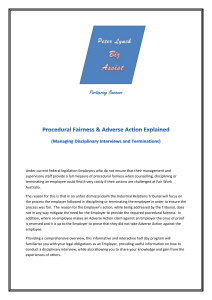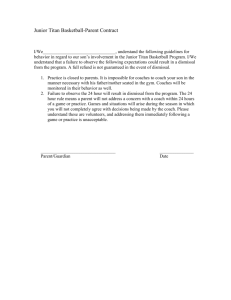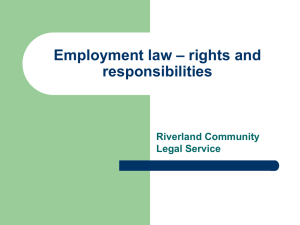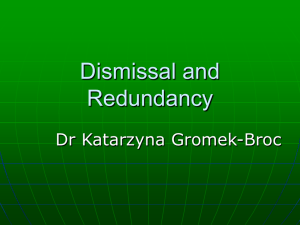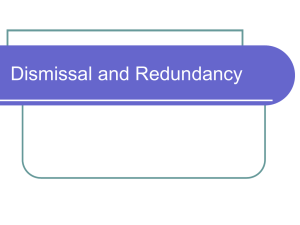full paper (Office document, 42kB)
advertisement
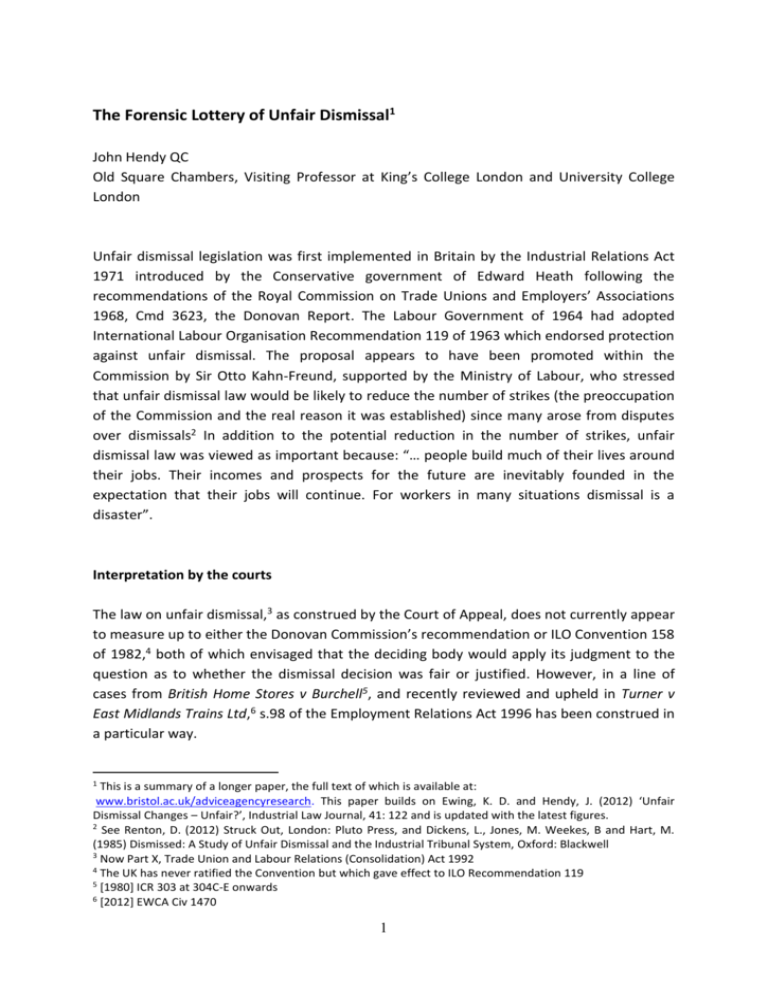
The Forensic Lottery of Unfair Dismissal1 John Hendy QC Old Square Chambers, Visiting Professor at King’s College London and University College London Unfair dismissal legislation was first implemented in Britain by the Industrial Relations Act 1971 introduced by the Conservative government of Edward Heath following the recommendations of the Royal Commission on Trade Unions and Employers’ Associations 1968, Cmd 3623, the Donovan Report. The Labour Government of 1964 had adopted International Labour Organisation Recommendation 119 of 1963 which endorsed protection against unfair dismissal. The proposal appears to have been promoted within the Commission by Sir Otto Kahn-Freund, supported by the Ministry of Labour, who stressed that unfair dismissal law would be likely to reduce the number of strikes (the preoccupation of the Commission and the real reason it was established) since many arose from disputes over dismissals2 In addition to the potential reduction in the number of strikes, unfair dismissal law was viewed as important because: “… people build much of their lives around their jobs. Their incomes and prospects for the future are inevitably founded in the expectation that their jobs will continue. For workers in many situations dismissal is a disaster”. Interpretation by the courts The law on unfair dismissal,3 as construed by the Court of Appeal, does not currently appear to measure up to either the Donovan Commission’s recommendation or ILO Convention 158 of 1982,4 both of which envisaged that the deciding body would apply its judgment to the question as to whether the dismissal decision was fair or justified. However, in a line of cases from British Home Stores v Burchell5, and recently reviewed and upheld in Turner v East Midlands Trains Ltd,6 s.98 of the Employment Relations Act 1996 has been construed in a particular way. 1 This is a summary of a longer paper, the full text of which is available at: www.bristol.ac.uk/adviceagencyresearch. This paper builds on Ewing, K. D. and Hendy, J. (2012) ‘Unfair Dismissal Changes – Unfair?’, Industrial Law Journal, 41: 122 and is updated with the latest figures. 2 See Renton, D. (2012) Struck Out, London: Pluto Press, and Dickens, L., Jones, M. Weekes, B and Hart, M. (1985) Dismissed: A Study of Unfair Dismissal and the Industrial Tribunal System, Oxford: Blackwell 3 Now Part X, Trade Union and Labour Relations (Consolidation) Act 1992 4 The UK has never ratified the Convention but which gave effect to ILO Recommendation 119 5 [1980] ICR 303 at 304C-E onwards 6 [2012] EWCA Civ 1470 1 S.98(1) provides first that the employer bears the burden of showing what the reason for the dismissal was and that it was one of a number of specified legitimate reasons or “some other substantial reason of a kind such as to justify the dismissal of an employee holding the position which the employee held”. The language of the legislation clearly permits the ET to make up its own mind as to the reasonableness of the decision to dismiss and the notions of equity and the merits of the case infer an impartial balance between the interests of the parties. But the authorities hold otherwise. Elias LJ in Turner cited Aikens LJ in Orr v Milton Keynes Council7 as a summary of the law which cannot be bettered. Aikens LJ held that in deciding the reasonableness of the decision to dismiss (in a misconduct case – but the principles apply across the board), that the ET: “…must consider, by the objective standards of the hypothetical reasonable employer, rather than by reference to its own subjective views” and “…must not simply consider whether they think that the dismissal was fair and thereby substitute their decision as to what was the right course to adopt for that of the employer”. Indeed, his judgment establishes the following remarkable proposition: “An ET must focus their attention on the fairness of the conduct of the employer at the time of the investigation and dismissal (or any appeal process) and not on whether in fact the employee has suffered an injustice”. The irrelevance of whether the employee has suffered an injustice is, as we have seen, in marked contrast to the intentions of Lord Donovan and the ILO. In fact the restrictions on the tribunal’s role go yet further. It is precluded from even making findings of fact in relation to the allegations on which the dismissal decision was based.8 It is thus irrelevant that the evidence against the employee is insufficient to satisfy the tribunal of his guilt, if by the standards of a reasonable employer, the investigation and conclusion was reasonable.9 Elias LJ in Turner uncontroversially pointed out that the band of reasonable responses (BoRR) test “does not simply apply to the question whether the sanction of dismissal was permissible; it bears upon all aspects of the dismissal process”. This includes whether the procedures adopted by the employer were adequate and whether the pre-dismissal investigation was fair and appropriate. Rate of success in unfair dismissal cases10 7 [2011] 4 All ER 1256 London Ambulance etc v Small [2009] IRLR 563 CA see paras.3, 5, 11, 17, 22, 30, 31, 40-46 9 HSBC Bank v Madden [2000] ICR 1283 at 1287C-1288A, 1295D-H, 1296C-D, CA (CA); Sainsbury Supermarkets plc v Hitt [2003] ICR 111 at 119H-120H, CA 10 Much of what follows is taken from Ewing, K. D. and Hendy, J. (2012) ‘Unfair Dismissal Changes – Unfair?’, Industrial Law Journal, 41: 122 8 2 There can be no doubt that the BoRR test is a principal cause for the depressing inequality of outcomes between workers and employers in unfair dismissal claims. The statistics11 show that between 2009-10 and 2010-11 the number of unfair dismissal claims fell from 57,400 to 47,900, a drop of 9,500 (16.6%), and between 2010-11 and 201112 dropped again by a further 1,300 to 46,300 (i.e. 19.4% in two years).12 Of the 46,100 unfair dismissal claims disposed of in the last year,13 11,300 were withdrawn by the claimant,14 4,000 were struck out by the tribunals without a hearing and a further 1,300 dismissed at a preliminary hearing. A further 19,500 reached a conciliated settlement. There were 1,200 judgments by default. That left 8,700 cases which went to a full hearing. There, the tribunals dismissed 4,800 cases and 3,900 were successful. In round terms, the tribunals dismissed 10,100 claims and upheld 3,900 which means that, amongst those cases which are not settled or withdrawn, employers have a 72% chance of winning and workers a 28% chance of winning. Overall, of the 46,100 unfair dismissal claims disposed of, only 8.4% were upheld by tribunals. The low proportion of cases which survive to and then succeed at final hearing is not entirely explained by the employers’ BoRR test. There are other factors: firstly, the effectiveness of the ACAS conciliation process; secondly a significant number of strong cases withdrawn on settlement without ACAS intervention; and thirdly, the effectiveness of the procedures for eliminating weak cases. Remedies It seems at first sight remarkable that of the 3,900 successful cases plus the 1,200 judgments by default, compensation was awarded in only 2,300 of them. The remedy is recorded as having been left to the parties in 120 cases but in 2,600 cases it is stated that no award was made. It may still be the case that compensation was determined by agreement in some of those successful cases. But the stark statistic means that compensation was ordered in only 63% of successful claims, 20.5% of claims which reached final hearing and a mere 5% of all unfair dismissal claims disposed of. 11 Ministry of Justice (2010) Employment and EAT Statistics, 2009-2010; Ministry of Justice (2011) Employment and EAT Statistics, 2010-11; and Ministry of Justice (2012) Employment and EAT Statistics,2010-2011 12 Instead and contrary to the evidence, the media insist on promoting the myth of employers beset by rising numbers of claims, e.g. Louisa Peacock, the Daily Telegraph, 27th October 2011. 13 Most of the claims dealt with were, of course, lodged in the previous year – so the figure is distinct from the number of claims lodged in the latest year. 14 Statistics do not reveal how many of these were by reason of a settlement reached with the former employer nor how many were withdrawn by claimants feeling that their case had become hopeless or too expensive or who just felt bogged down by the lengthy and complex procedures. 3 The level of compensation is particularly striking. The MoJ statistics show that the median award of unfair dismissal compensation (that is both the basic and the compensatory elements combined) fell slightly from £4,591 in 2010-2011 to £4,560 in 2011-12 (average award: £9,133). Another way to view this is to note that approximately compensation was less than £2,000 in approximately 30% of awards and in excess of £50,000 in 1%. Yet now the government is determined, in the light of the Beecroft Report, to reduce awards still further. Recovery of compensation As if the chances of an award of compensation and the size of the likely award were not bad enough, MoJ research shows that even when compensation is ordered to be paid (not just in unfair dismissal cases) there are extreme difficulties associated with recovery of it.15 More than 42 days after judgment had been given, only 53% of claimants had been paid in full. And 12 months after judgment 31% of claimants still had not been paid at all.16 Amongst the reasons for non-payment, 39% were not paid because the employing company was no longer in existence and 29% because the employer refused to pay.17 The so-called primary remedy for unfair dismissal is an order for reinstatement or reengagement. The frequency with which they are achieved is staggeringly low. In 2011-12 there were but five. The statistics do not reveal how many such orders were in fact complied with since the statute provides that the employer cannot be compelled to comply with a reinstatement or re-engagement order.18 It is likely that a significant proportion of this tiny number of orders are not complied with. These figures make a mockery of fair access to justice in the employment tribunal. Restricting eligibility 15 Adams, L., Moore, A., Gore, K. and Brown, J. (2009) Research into the Enforcement of Employment Tribunal Awards in England and Wales, Ministry of Justice Research Series 9/09 16 Adams, L., Moore, A., Gore, K. and Brown, J. (2009) Research into the Enforcement of Employment Tribunal Awards in England and Wales, Ministry of Justice Research Series 9/09, pp30-31 17 Adams, L., Moore, A., Gore, K. and Brown, J. (2009) Research into the Enforcement of Employment Tribunal Awards in England and Wales, Ministry of Justice Research Series 9/09, p40 18 Though increased compensation may be payable in those circumstances: s.117 Employment Rights Act 1996. 4 In the light of the statistics it might seem illogical to restrict access to unfair dismissal protection still further. Yet, as others describe in this book, the attack has been extensive. On 3rd October 2011 George Osborne announced at the Conservative Party Conference that from April 2012 workers will have to be employed for two years instead of one year to qualify for unfair dismissal protection.19 Vince Cable explained that these changes are needed because “businesses tell us that unfair dismissal rules are a major barrier to taking on more people.”20 It turns out that the principal evidence for this was a survey of the members of the Institute of Directors in which 51% of an unknown number of respondents said that a reduction of qualifying period to one year would be a significant or very significant factor in considering whether to take on an additional employee. 21 As the BIS Final Impact Assessment admits “this nature of data has its limitations.”22 It might be thought curious that extending the right of employers to sack workers unfairly would create jobs and a detailed report by the OECD, “Employment Protection and Labour Market Performance” in Employment Outlook 2004 concluded that “[c]onsistent with prior studies, there appears to be little or no association between employment protection legislation strictness and overall unemployment”. The government claims that the change to the law will prevent 2,100-3,200 unfair dismissal claims (which those dismissed amongst these 2.5 - 3 million workers would otherwise have lodged).23 This, it is said, will save employers £6 million.24 Yet unfair dismissal trends from 2009 to 2012 show, as we have seen above, that without the change to eligibility the number of unfair dismissal claims fell in two years by 11,100, nearly six times the number of claims which will be prevented by depriving 2.5 – 3 million workers of unfair dismissal protection. If the estimate of unfair dismissal cases which the government claim will be avoided by the extension of the qualifying period is assumed to be 2,700 and that those claims would have been disposed of in the same proportions as the unfair dismissal claims in last year’s statistics, we can calculate that employers nationally will be spared some 130 claims in 19 http://www.conservatives.com/News/Speeches/2011/10/Osborne_together_we_will_ride_out_the_storm.as px. 20 Press release, 3rd October 2011 21 Department for Business Innovation and Skills (2011) Resolving Workplace Disputes: Final Impact Assessment, paragraph 302 22 Department for Business Innovation and Skills (2011) Resolving Workplace Disputes: Final Impact Assessment 23 Mr Cable’s press release (above) estimated 2,000 but the basis of the assertion is unclear. The figure is significantly less than the equally unsupported original estimate of 3,700-4,700: initial Impact Assessment, op cit., at 35 and 153. The final Impact Assessment¸op cit., at 84 puts the figure at 2,100-3,200. See further Anya Palmer, “Opinion: Unfair Dismissal Claims”, The Lawyer, 4 October 2011. 24 Financial Times, 4th October 2011. The Department for Business Innovation and Skills (2011) Resolving Workplace Disputes: Final Impact Assessment, puts it at between £5.8m and £8.9m. 5 which workers would be found to have been unfairly dismissed and would have been awarded modest compensation.25 Costs Costs or the threat of them have become a significant disincentive for employees. Costs were ordered in 1,411 cases (not just unfair dismissal claims), in favour of the employer in 1,295 cases and in favour of the employee in 116 cases. The proportion of costs orders is therefore 91.8% in favour of the employer and 8.2% in favour of the worker. The unacceptable burden The burden on employers is apparently the cost of defending against hopeless claims.26 However, the rate of strike-out and dismissal of claims at an early stage (11.5%) is obviously significant. Furthermore the frequency of costs orders is rising dramatically and their threat becoming more frequent. These factors may well play an important part in the voluntary withdrawal of 24.5% of unfair dismissal claims. The fact of the matter is that employers are only obliged to defend themselves in a full hearing in 21.5% of cases (ie 9,900 cases), of which they win 5,100 and lose 4,800, a statistic which suggests a significant proportion of meritorious cases. The argument, stripped down to its essentials, is that because the law is so unbalanced that the vast majority of unfair dismissal claims fail to achieve a worthwhile remedy, employers should be spared the expense of all claims, good, bad or indifferent from those in their second year of employment. The proposition is preposterous in terms of legal logic and, anyway, does not reflect the reality that lies behind the statistics. It is against this background that the inhibition of further unfair dismissal claims by the new fees regime must be seen, to say nothing of the proposal to permit employers to buy out the right to unfair dismissal and other rights for £2,000 of shares (a proposal which will likely become a mandatory condition for success in a job application). Fees 25 The level of compensation in these hypothetical cases may confidently be assumed to be lower than last year’s median because employees in their second year of employment will not have acquired sufficient service for any but a modest ‘basic’ award. The equivalent saving is to be enjoyed by employers who, by definition, have acted so unfairly that no reasonable employer would have dismissed the workers concerned. 26 The employers’ estimate is that the average claim costs £8,500 to defend. Mr Cable (speech to EEF, 23 rd November 2011, note 5) puts the average at £4,000). There appears no empirical evidence for either figure. 6 Notwithstanding the statistics, Mr Osborne claims that introducing tribunal fees would end “the one way bet against small businesses.”27 In fact, the introduction of fees for the often low paid and usually unemployed workers who use the unfair dismissal regime will surely suppress practically all bets by claimants. It will take a claimant with nerves of steel, unquenchable optimism and an insatiable desire for vengeance at any cost to pursue these odds. Any experienced gambler would walk away. It is hard to see that any more than a trickle of unfair dismissal claims will, after the introduction of this fees regime, reach the tribunals. If so, thousands of claimants will feel forced to under-settle good claims, give up or not submit a claim in the first place. Conclusion As Professor Ewing and I wrote in 2011,28 the truth is that unfair dismissal law does not impose undue burdens on business. Rather, it offers minimal protection for workers: too many are excluded from the legislation; it is too easy for an employer to justify a dismissal as not being ‘unreasonable’; and the remedies for those who are dismissed remain wholly inadequate. This is the legal regime that needs reform. 27 28 Financial Times, 3rd October 2011 Ewing, K. D. and Hendy, J. (2012) ‘Unfair Dismissal Changes – Unfair?’, Industrial Law Journal, 41: 122 7

